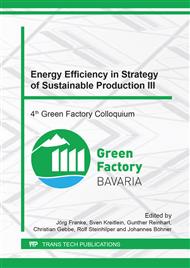p.11
p.20
p.27
p.36
p.44
p.52
p.60
p.69
p.77
A Quick Reaction System Using Energy, Process and Quality Data for Process Characterization and Holistic Monitoring of Large Scale Assembly Lines
Abstract:
Modern large-scale assembly lines need to deliver a highly varied and flexible output, while achieving 0 ppm scrap. This is becoming more and more demanding due to an increasing complexity of the products. Thus, it will be a major step in manufacturing processes to develop process monitoring strategies which increase productivity as well as flexibility and reliability of the entire assembly process. Therefore, it is necessary to advance the entire chained assembly line instead of only isolated processes and stations. For this reason, technological processes have to be assessed as a chain of upstream and downstream partial processes instead of being considered in isolation. [3] Moreover, data mining projects depend on the available data bases, while additional data sources may increase the derived knowledge. [2] These ideas are extendable by energy data measurements, besides process and quality data. Existing monitoring approaches to reduce scrap usually use dashboards linked with process and quality data. [5] Therefore, this paper presents a new methodology using data mining analysis of energy data for assembly presses as well as complete assembly lines for electromagnetic actuators. This novel holistic approach realized by a Quick Reaction System allows to increase efficiency, while decreasing energy and resource consumption for actuator manufacturing on large scale assembly lines. In particular, the data base consists of process and quality data, enriched by energy data measurements. This approach enables a comprehensive process characterization as well as monitoring of whole assembly lines by using data mining tools. Furthermore, this paper describes a quantitative evaluation of its data mining based event detection of critical process parameters.
Info:
Periodical:
Pages:
44-51
Citation:
Online since:
October 2017
Authors:
Price:
Сopyright:
© 2017 Trans Tech Publications Ltd. All Rights Reserved
Share:
Citation:


